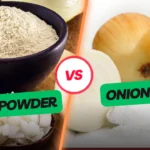Matcha, a powdered green tea originating from Japan, has gained popularity worldwide for its unique flavor and numerous health benefits. But precisely what does matcha taste like? To answer this question, we must delve into the characteristics and nuances of this vibrant green beverage in this post.
So, let’s get started!
What Is Matcha?
Green tea in the form of powder called matcha is a Japanese invention. It is created from finely ground, shade-grown tea leaves. Before harvest, shade cloths are placed over the tea plants in the cultivation and preparation of matcha to increase the chlorophyll content and produce a vivid green color. The leaves are harvested, steamed, dried, and then processed into a fine powder using conventional stone mills. Matcha has a distinctive flavor that is frequently characterized as earthy, vegetal, and somewhat sweet.
It is frequently used in Japanese tea ceremonies and has grown in popularity worldwide due to its many health advantages. Matcha is a healthy beverage option since it has high quantities of antioxidants, vitamins, minerals, and amino acids. Additionally, it has been shown to increase metabolism, sharpen attention and concentration, encourage relaxation, and enhance general well-being.
What Does Matcha Do?

The green tea powder known as matcha has several health advantages. It is abundant in antioxidants called catechins, especially epigallocatechin gallate (EGCG), which is associated with several health benefits.
By enhancing fat oxidation, matcha can increase metabolism and aid in weight reduction. Because L-theanine, an amino acid that encourages relaxation without making you sleepy, is present, it also gives you calm and concentrated energy. Memory, attention span, and brain function may all be improved by matcha.
It also promotes cardiovascular health by lowering blood pressure and cholesterol levels. Its potent antioxidant concentration aids in preventing inflammation and chronic disorders. Along with minerals like calcium and potassium, matcha also has vitamins A, C, and E. It can help detoxify by fostering liver health and toxin removal from the body. Additionally, matcha has antimicrobial qualities that can aid in treating infections and enhance dental health. Matcha is a multipurpose superfood that has a variety of health advantages.
What Does Matcha Taste Like?
The flavor profile of matcha, a distinctive and sophisticated kind of powdered green tea, is unique. It is frequently said to have a rich, vegetal flavor with a tinge of sweetness and a faint bitterness. Grassy, earthy, and umami elements may be found in the taste. Depending on the grade and quality of the tea used, as well as the manner of preparation, matcha’s flavor might change. Due to its intensity and distinctive attributes, it may take some individuals some time to become used to it. Overall, matcha gives a flavor experience unlike any other kind of tea, one that is energizing and refreshing.
Health Benefits Of Matcha
Here are some of the potential health benefits of matcha you need to know:
Rich in Antioxidants
One of the vital health benefits of matcha is its high antioxidant content. Antioxidants are compounds that help protect the body against oxidative stress and damage caused by free radicals. Matcha contains a specific type of antioxidant called catechins, particularly epigallocatechin gallate (EGCG), known for its potent antioxidant activity. EGCG has been shown to have various health benefits, including reducing inflammation, protecting against chronic diseases such as heart disease and cancer, and promoting healthy aging.
Boosts Brain Function
Matcha contains caffeine, which can help improve brain function and increase alertness. However, unlike coffee, matcha also contains an amino acid called L-theanine, which has calming effects on the brain. The combination of caffeine and L-theanine in matcha provides a balanced energy boost without the jitters or crashes often associated with coffee consumption. L-theanine also promotes relaxation and helps reduce stress and anxiety. Studies have shown combining caffeine and L-theanine in matcha can enhance cognitive performance, attention, and memory.
Supports Weight Loss
Matcha has been found to have potential benefits for weight loss and management. It contains compounds that can help boost metabolism and increase fat oxidation. One study found that consuming matcha increased thermogenesis (the body’s rate of burning calories) by 8-10% compared to a placebo. Matcha also contains a type of fiber called soluble fiber, which can help promote feelings of fullness and reduce appetite. Additionally, matcha is low in calories and can be a healthier alternative to sugary beverages or snacks.
Enhances Detoxification
Matcha has been traditionally used in Japanese tea ceremonies for its detoxifying properties. The high chlorophyll content in matcha gives it its vibrant green color and contributes to its detoxifying effects. Chlorophyll helps remove toxins, heavy metals, and harmful chemicals from the body. Matcha also contains compounds called catechins, which have been shown to support liver health and aid in detoxification.
Supports Heart Health
Regular consumption of matcha has been associated with several benefits for heart health. The antioxidants in matcha, particularly EGCG, have been shown to help reduce LDL cholesterol levels (the “bad” cholesterol) and increase HDL cholesterol levels (the “good” cholesterol). High levels of LDL cholesterol are a risk factor for heart disease, while higher levels of HDL cholesterol are protective. Matcha may also help lower blood pressure and reduce the risk of developing heart disease.
How To Choose The Best Matcha?
Here is how you can choose the best matcha for yourself:
- Look for high-quality matcha sourced from Japan, specifically from regions like Uji, Nishio, or Kyoto.
- Check for the grade of matcha. Ceremonial-grade matcha is the highest quality and is best for drinking, while culinary-grade matcha is more suitable for cooking and baking.
- Examine the color of the matcha. High-quality matcha should have a vibrant green color, indicating that it was made from young tea leaves.
- Consider the aroma of the matcha. It should have a fresh and grassy scent without any off-putting or artificial smells.
- Read the product description and packaging carefully. Look for keywords like “stone-ground,” “shade-grown,” and “organic” to ensure a higher quality product.
- Check for certifications such as USDA Organic, JAS (Japanese Agricultural Standard), or ISO (International Organization for Standardization) to ensure that the matcha meets specific quality standards.
- Consider the price. While high-quality matcha can be more expensive, excessively cheap options may indicate lower quality or adulteration.
- Read customer reviews and ratings to get an idea of other people’s experiences with the specific brand or product.
- Purchase matcha from reputable sources such as specialty tea shops, Japanese tea companies, or trusted online retailers.
Factors That Affect Matcha Taste
Here are some of the factors that affect the match’s taste badly.
Quality of Tea Leaves
The quality of the tea leaves used to make matcha plays a crucial role in determining its taste. Matcha is made from shade-grown tea leaves, which are carefully selected and harvested. The highest quality matcha is made from young leaves picked by hand. These leaves have a vibrant green color and a tender texture, resulting in a smoother and more delicate flavor.
Lower-quality matcha, on the other hand, is often made from older leaves or a blend of different tea leaves. These leaves may have a duller green color and a coarser texture, leading to a less refined taste. Additionally, the presence of stems and veins in lower-quality matcha can contribute to a bitter or astringent flavor.
Growing Conditions
The tea plants’ growing conditions can significantly impact matcha’s taste. Matcha is primarily produced in Japan, where specific regions are renowned for their high-quality tea cultivation. Factors such as soil composition, altitude, climate, and weather patterns all influence the flavor profile of matcha.
Tea plants grown in nutrient-rich soil tend to produce matcha with a more complex and robust taste. The altitude at which the plants are cultivated also affects the flavor; higher altitudes often result in teas with a sweeter and more mellow character. Furthermore, variations in temperature and rainfall patterns throughout the year can influence the chemical composition of the tea leaves, ultimately affecting their taste.
Processing Methods
The process of transforming tea leaves into matcha can significantly impact their taste. The traditional way of producing matcha involves several meticulous steps, including steaming, drying, and grinding the leaves into a fine powder using granite stone mills. This labor-intensive process helps to preserve the natural flavors and nutrients of the tea leaves.
The steaming process’s duration and temperature can affect matcha’s taste. Longer steaming times can result in a more vegetal and grassy flavor, while shorter steaming times may produce a sweeter and more floral taste. Additionally, the grinding process plays a crucial role in achieving matcha powder’s desired texture and consistency. Slower grinding speeds are often preferred as they generate less heat, preserving the delicate flavors of the tea leaves.
Storage and Freshness
Proper storage and freshness are essential for maintaining the taste of matcha. Matcha should be stored in airtight containers away from light, heat, and moisture to prevent oxidation and degradation of flavor. Exposure to these elements can lead to a loss of aroma and a decline in taste quality.
Freshly ground matcha tends to have a more vibrant and pronounced flavor than matcha stored for an extended period. It is recommended to consume matcha within six months to one year after its production date to ensure optimal taste.
Preparation Techniques
The way matcha is prepared also affects its taste. Traditional Japanese tea ceremonies emphasize precise measurements and techniques to achieve the desired flavor profile. The amount of matcha powder used, water temperature, whisking speed, and duration contribute to the overall taste experience.
Using too much matcha powder or hot water can result in a bitter taste, while using too little may lead to a weak or diluted flavor. Whisking the matcha vigorously creates a frothy texture and enhances its umami characteristics.
How To Make A Matcha Latte?
Here is a step-by-step guide on how to make a delicious matcha latte just like the Starbucks matcha:
Ingredients:
One teaspoon of high-quality matcha powder
One tablespoon of hot water (not boiling)
1 cup of milk (dairy or plant-based)
Sweetener of choice (such as honey, maple syrup, or sugar)
Optional: vanilla extract or flavored syrup for added taste
Equipment:
Matcha whisk or small whisk
Small bowl or cup for whisking
Saucepan or milk frother for heating the milk
Mug or cup for serving
Step 1: Heat the Milk
Start by heating the milk in a saucepan over medium heat or using a milk frother. Heat it until it reaches your desired temperature, but avoid boiling it, as it can affect the taste and texture. If using a saucepan, stir occasionally to prevent scorching.
Step 2: Prepare the Matcha
While the milk is heating, measure one teaspoon of matcha powder into a small bowl or cup. It’s essential to use high-quality matcha powder for the best flavor and vibrant green color. Lower-quality matcha may result in a duller color and less intense taste.
Step 3: Add Hot Water
Pour one tablespoon of hot water (not boiling) into the bowl with the matcha powder. Using water that is too hot can make the matcha taste bitter, so it’s best to let it cool slightly before adding it to the powder.
Step 4: Whisk the Matcha
Using a matcha whisk or small whisk, vigorously whisk the matcha and hot water together in a zigzag motion until it becomes frothy and well combined. This step is crucial for achieving a smooth and creamy texture in your latte. If you don’t have a whisk, you can use a fork or a small electric frother.
Step 5: Sweeten to Taste
If desired, add your preferred sweetener to the matcha mixture. The amount of sweetener will depend on your preference and the quality of matcha used. Start with a small amount and adjust accordingly. Honey, maple syrup, or sugar are commonly used options but feel free to experiment with other sweeteners.
Step 6: Combine Matcha and Milk
Once the milk is heated to your liking, pour it into the bowl with the matcha mixture. Use a spoon to hold back the foam while running if you prefer less foam in your latte. Gently stir or whisk until the matcha and milk are thoroughly combined.
Step 7: Optional Flavoring
If you want to add extra flavor to your matcha latte, you can incorporate a splash of vanilla extract or flavored syrup. This step is optional but can enhance the taste profile according to your preferences.
Step 8: Serve and Enjoy
Pour the prepared matcha latte into a mug or cup of your choice. You can sprinkle some additional matcha powder on top for garnish if desired. Sip and savor your homemade matcha latte while it’s still warm.
How To Store Matcha?
Here is how you can store matcha:
Choose the Right Container
The first step in storing matcha is selecting an appropriate container. It is recommended to use an airtight container made of opaque material, such as tin or ceramic. This type of container helps to protect matcha from exposure to light, air, moisture, and odors, which can degrade its quality over time.
Keep Away from Light
Matcha is highly sensitive to light and can quickly lose its vibrant green color when exposed to sunlight or artificial light sources. Therefore, it is crucial to store matcha in a dark place, such as a pantry or cupboard. Avoid placing it near windows or other areas where it may be exposed to direct light.
Avoid Heat and Moisture
Heat and moisture are the enemies of matcha, as they can cause oxidation and spoilage. It is essential to store matcha in a cool and dry environment. Avoid storing it near stoves, ovens, or any other heat sources. Additionally, ensure the container is tightly sealed to prevent moisture from entering.
Refrigeration
While refrigeration may seem like a good idea to prolong the shelf life of matcha, it is generally not recommended. The fluctuating temperatures inside the refrigerator can cause condensation, which can lead to moisture absorption by the matcha powder. This can result in clumping and degradation of quality. However, refrigeration might be necessary to prevent spoilage if you live in a hot and humid climate. In such cases, ensure the matcha is stored in an airtight container and allow it to come to room temperature before opening to avoid condensation.
Freezing
Freezing matcha is not recommended, as it can alter its flavor and texture. The moisture present in the freezer can cause the matcha powder to clump and lose its delicate taste. Consuming matcha within its recommended shelf life is best rather than freezing it.
Avoid Excessive Air Exposure
Exposure to air can lead to oxidation, resulting in a loss of flavor and aroma. To minimize air exposure, permanently seal the container tightly after each use. Choose a container with a vacuum-sealed lid or use a vacuum sealer to remove excess air before sealing.
Consume Freshly Opened Matcha
Matcha is at its best when consumed fresh. Once opened, it is recommended to use matcha within three to six months for optimal flavor and quality. Over time, matcha may lose its vibrant green color and develop a stale taste. Therefore, it is advisable to purchase matcha in small quantities that can be consumed within a reasonable period.
Avoid Contamination
To prevent cross-contamination and preserve the unique flavor of matcha, it is essential to use clean utensils when handling the powder. Avoid using wet spoons or scoops, as moisture can cause clumping and spoilage. Additionally, ensure the container used for storing matcha is thoroughly cleaned and dried before transferring the powder.
Keep Away from Strong Odors
Matcha has a delicate flavor profile that can easily absorb odors from its surroundings. It is crucial to store matcha away from strong-smelling substances such as spices, coffee, or cleaning agents. This will help maintain the integrity of its taste and aroma.
Labeling and Rotation
If you have multiple containers of matcha or different varieties, it is advisable to label them with the purchase date or expiration date. This will help you keep track of the freshness and ensure that older matcha is used first. Proper rotation ensures that you always consume matcha at its peak flavor.
Conclusion
In conclusion, matcha is a unique and distinct type of green tea that offers a rich and complex flavor profile. Its taste can be described as vegetal, grassy, and slightly bitter, with a hint of sweetness. The umami notes add depth and complexity to the overall taste experience. Matcha also has a smooth and creamy texture, which enhances its enjoyable mouthfeel. The flavor of matcha can vary depending on the quality and grade of the tea, as well as the preparation method used. Overall, matcha provides a refreshing and invigorating taste that tea enthusiasts worldwide highly appreciate.
Frequently Asked Questions (FAQ’s)
Does Matcha Taste Like Green Tea?
Yes, matcha does taste like green tea as it is made from the same plant, Camellia sinensis. However, matcha has a distinct flavor profile that sets it apart from regular green tea, characterized by a rich, umami taste and a slightly bitter undertone.
Is Matcha Sweet?
Matcha is not inherently sweet, but it has a unique umami flavor that can be described as slightly vegetal and mildly bitter. Its taste can vary depending on the quality and preparation method.
Does Matcha Have Caffeine?
Yes, matcha contains caffeine. It is a type of green tea made from powdered tea leaves, and it typically has higher levels of caffeine than regular brewed green tea.
How To Make Matcha Taste Good?
To make matcha taste good, you can add a sweetener like honey or sugar, experiment with different milk options such as almond or coconut milk, and incorporate flavors like vanilla or cinnamon. Additionally, adjusting the water-to-match ratio and using high-quality matcha powder can significantly enhance the taste.
Why Does Matcha Taste Like Fish?
Matcha does not taste like fish. It has a unique flavor profile that is often described as earthy, vegetal, and slightly bitter, but it does not resemble the taste of fish.
Does Matcha Taste Like Seaweed?
Matcha can taste like seaweed due to its unique flavor profile, which is characterized by umami notes that resemble the taste of seaweed. This distinct taste results from the high levels of amino acids, particularly L-theanine, present in matcha tea leaves.






